Grounding of power equipment and commercial networks
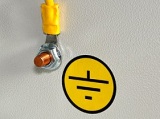 Why are electrical installations grounded, what danger do ungrounded circuits pose to people, and finally, in what cases and how is grounding done in industry? Our and other questions will be answered in our article. You will learn how to install grounding wires, how to lay wires for them under different conditions; what is prohibited and what is allowed to be used for the protective earthing device. We will talk about the nuances of grounding cable sheaths and how wires are laid in dry and wet rooms.
Why are electrical installations grounded, what danger do ungrounded circuits pose to people, and finally, in what cases and how is grounding done in industry? Our and other questions will be answered in our article. You will learn how to install grounding wires, how to lay wires for them under different conditions; what is prohibited and what is allowed to be used for the protective earthing device. We will talk about the nuances of grounding cable sheaths and how wires are laid in dry and wet rooms.
Despite the fact that the wires of electrical networks are electrically isolated from each other and from the ground, the insulation of the wires cannot interfere with capacitive currents, since the electrical network and the ground form the plates of an elongated capacitor, between which there is a capacitive current that inevitably flows. That is, there is always a parasitic circuit that is shorted to ground through this capacitance. Therefore, in case of accidental contact, even touching an insulated wire, a person is exposed to the risk of electric shock.
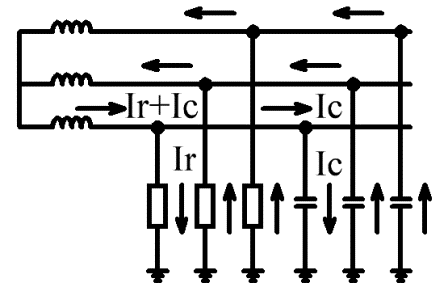
Of course, damage to wires with a high alternating potential is a much greater danger to people, but in order to protect against the consequences of short-circuiting the conductive boxes of the equipment, these sheaths themselves are previously connected to the ground with the help of earthing devices.
In various industrial electrical installations for voltages up to 1000 volts with a solidly grounded zero of a single-phase source or with a grounded neutral, as well as in permanent consumers with a solidly grounded neutral point, the reset is carried out so that in the event of an emergency, the opening will take place automatically and at the same time so fast... The reaction speed depends on the selected protective device.
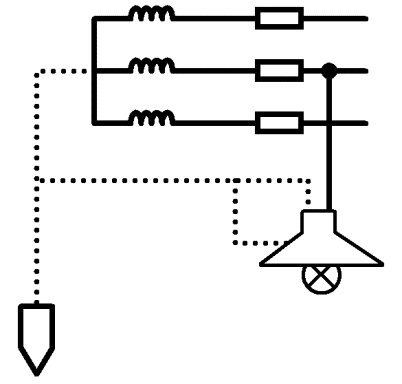
For this purpose, parts of the equipment that may accidentally come under high voltage in an emergency situation are neutralized, connected to a grounded neutral conductor of the network. For example, if the body of the lighting device is short-circuited and the body is neutralized, then the fuses will operate automatically and the voltage from the circuit will be immediately removed. PUE prescribe the installation of most 380 and 220 volt installations with a solidly grounded neutral (directly connected to the grounding device).
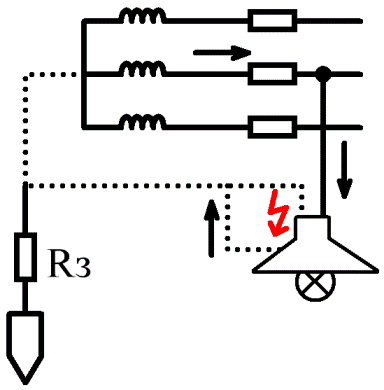
In electrical installations with a working voltage of up to 1000 volts with an isolated neutral and whenever the working voltage is higher than 1000 volts, earthing is carried out, the meaning of which is to reduce the current that can flow through a person to a negligibly small value.This is achieved by grounding parts of the equipment, and the grounding device must have a resistance significantly lower than that of the human body, which in turn has a resistance in the range of 800 Ohm — 100 kOhm, which depends on many factors, including physiological (health, shoes, clothes, etc.).
For electrical equipment with an isolated neutral and a class not exceeding 1000 volts, the resistance of the grounding circuit should not exceed 4 ohms, and for installations with a grounded neutral: for 660 V — not more than 2 ohms, for 380 V — not more than 4 Ohms, and for 220 V — no more than 8 Ohms. For high-voltage equipment rated from 3000 to 35000 volts, the resistance of the grounding devices is calculated using the formula 125 / (current to ground during fault) while normalized to a maximum of 10 ohms.
If grounding is common for equipment with different voltage classes, then its resistance must be less than or equal to the upper limit values, otherwise the protection will not give the necessary effect in terms of safety due to a significant voltage drop on the equipment elements.
Electrical installations with alternating three-phase current for 380 and more volts; Direct current equipment for 440 volts or more, always complete with neutral or ground. In workshops with a special hazard, as well as in outdoor installations with an alternating voltage of 42 volts, and in equipment with a direct voltage of 110 volts, they also always do grounding or grounding. Explosive equipment without options is zeroed or grounded, regardless of the operating voltage level, because any accidental spark or heating can lead to tragedy.
Neutral or grounded external elements of transformers, motors and generators, lighting devices, various devices, as well as drives, measuring coils of current transformers, external casings of panels, movable and movable elements of structures with electrical equipment installed in them, cable bushings and others cable structures that conduct braids of both wires and cables, conductive tubes for the protection of electrical wires, busbar frames, cables, etc. This applies to both stationary and mobile electrical equipment, both of which are found in industry.
But there are times when grounding is not necessary. So, they do not ground and do not ground the housings equipped with additional insulation and the housings of those electrical consumers that are not connected directly to the network, but through an isolation transformer. It is allowed not to perform grounding at all and not to ground enclosures installed directly on already grounded or grounded conductive structures with a reliable contact between them. This is not the subject of this article, but such protection measures against indirect contact are intended to protect electrical installations.
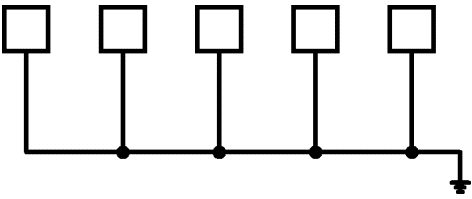
Each of the neutral or earth elements of the composite electrical receiver is connected to the neutral or earth network by its own personal tap. It is forbidden to connect parts of the protected installation in series with each other and then in the protective neutral or in the grounding conductor.
Nevertheless, several different structures, such as crane framing and rails, can be connected in series if they are used directly as neutral protection or earthing busbars, or if they are themselves earthing or earthing lines. However, each bolt on the neutral or ground line secures a separate wire.
When a person works with a power tool, he is still touching the conductive casing, and in case of insulation problems, the casing can sometimes be affected by mains voltage, which is dangerous for the worker. The installation power tool is often powered from the shield, where the fuses act as protective devices, but only trip when a significant current is drawn. But the resistance of the wire in the closing loop plays against us, and the protective operation can take more than a second, and this is already dangerous for the human body.
To avoid risk, automatic residual current devices are used, which have a time to operate for no more than 210 ms after the moment of ground or frame failure.
Protective devices of this type are of different types: for monitoring the continuity of the earthing circuit, for monitoring phase isolation (from earth), for protection against phase current entering the box, for protection against two-phase or single-phase faults with earth, for protection against direct contact with vulnerable current to housing elements. The C-901 and IE-9807 consumer goods control devices have a sensitivity of 10 mA and a response time of less than 51 ms. Such devices do not allow the current to have time to harm a person.
For the purpose of grounding electrical installations, natural grounding conductors are primarily used, where the dispersion resistance meets the PUE. This can be a reinforced concrete foundation of a building, a buried water pipe, a casing, etc. Grounding of electrical equipment on pipelines with fuel transported through them, on cast iron pipes, on temporary pipelines is prohibited.
Primarily, standard operating neutral conductors function as neutral and ground conductors; wires for special purposes; conductive structures of buildings and parts of industrial structures, for example, elevator shafts, rails under cranes, etc., various pipelines, sheaths of power cables, electrical wiring boxes.
It is prohibited to use as grounding conductors: sheaths of insulating pipes, corrugations carrying cables, lead sheaths and protective armor of wires and cables, as they themselves must be properly grounded. Electrical installations and conductive elements of the building infrastructure, as well as all types of pipelines, are connected to the grounding or grounding network to equalize their potential. The natural contact of the metals in the joints is sufficient.
If an artificial earth electrode is still required, then buried, horizontal and vertical industrial earth electrodes are used. For their production, round steel with a diameter of 10 to 16 mm is usually used, more often strip steel 40 by 4 mm or angular 50 by 50 by 5 mm. Vertical ones are 2.5 to 5 meters long, screw (up to 5 meters) or drive (up to 3 meters) deep into the soil by hand or with the help of an electric or other special tool.
Electrical installations connected to the earth with a resistance of more than 200 Ohm-m are earthed with a deeply earthed electrode or the earth is additionally treated to increase in electrical conductivity — for vertical grounded electrodes, they are laid in alternating layers of Ca (OH) 2 or NaNO3 and the earth, and the diameter of such treatment is half a meter at one third of the height of the rod in its upper part. After finishing the laying of each of the layers, they are successively watered with water.
If there are areas of earth with higher conductivity nearby, they resort to remote grounding electrodes using additional cables or wires. In permafrost conditions, ground electrodes are installed in thawed areas, reservoirs, as well as in artesian-type wells.
Steel is traditionally used as a material for stationary grounding conductors, unless, of course, the fourth neutral conductor of a three-phase system (copper) is used for this. The table shows the minimum sizes for neutral and grounding conductors, including steel grounding conductors. At a voltage of an electrical installation with an isolated neutral of 1000 volts, the resistance of the grounding wires, according to PUE, cannot exceed the resistance of the phase wires by more than 3 times. The minimum permissible values of the cross-section are indicated in the tables.
For electrical installations with a voltage of up to 1000 volts, in industrial premises, in workshops, a grounding line is used, a steel bus with a cross-section of at least 100 sq. Mm, and for a voltage of more than 1000 volts, the minimum cross-section for it is 120 sq. Mm.The use of metal structures, pipelines, equipment as a working neutral conductor is prohibited.
Mobile electrical installations for grounding or grounding use a separate wire in the form of a core as part of a cable, in a single sheath common to phase wires, with the same cross-section as the phase wires.
For grounding and as protective neutral conductors on explosive equipment, in hazardous industries specialized wires are used. You can also use metal structures, steel pipes, cable sheaths, etc., but only as an auxiliary measure, first of all, there should be a special ground wire.
For explosive installations with a grounded neutral at a voltage of up to 1000 volts, the grounding of the supply networks is carried out with an additional laid wire: the fourth - for three-phase networks, and the third - for two-phase and single-phase networks. Even single-phase lighting networks in hazardous areas of class B-1 are equipped with a third protective conductor.
When natural structures do not meet PUE requirements, there is no other way out than to build artificial ground electrodes.
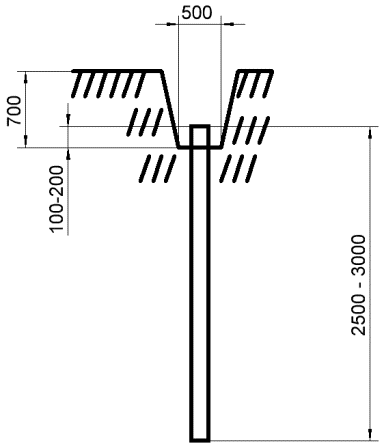
Recessed ground electrodes are installed, which are laid on the bottom of the pit already at the beginning of the installation of the foundation of the structure, at the construction stage. Vertical ground electrodes are driven or simply pressed into the ground using special devices, such as automatic pilot machines or hydraulic presses. The top is laid at an elevation of 0.6 to 0.7 meters below the level of the ground mark, and the height of the protrusion from the bottom of the pit is 0.1 to 0.2 meters.This is done so that it is then convenient to weld the connecting wires in the form of strips or cylindrical rods.
The conductors are connected in ground circuits by overlapping welding. If the soil is aggressive and can lead to corrosion of metals, then the cross-section of the grounded electrodes is increased, copper or galvanized grounded electrodes are used as a corrosion-resistant alternative, and for greater reliability anti-corrosion electrical (cathodic) protection is added.
Asbestos pipe protection is added to horizontal earthing conductors if they cross underground utilities, railroad tracks, and other structures that may contribute to causing mechanical damage to any of the intersecting structures. When the installation is completed and the foundation pit is ready for final backfilling, a mandatory act is drawn up where it is legally recorded that hidden laying has been carried out.
Neutral protective and earth conductors should, if possible, be readily accessible for diagnosis and inspection. This, of course, does not apply to the cores and sheaths of cables, pipes with hidden conductors and metal structures that are initially located in foundations and in the ground, neutral and grounding conductors installed in hidden, unserviceable and irreplaceable pipes.
If the room is dry, then the grounding wires are laid directly on the brick or concrete base, the conductive busbars are attached to it with dowels. In wet areas, spacers or holders are needed to keep the wire 1 cm or more from the base.
On straight surfaces of the foundation, the wires are fixed at a distance of 60-100 cm between the fasteners, and at bends - with a margin of 100 cm from the corner and from the branching points, at a distance of 40-60 cm from the floor and at least 5 cm from the movable ceilings of the channels ... Sleeves or mounting holes are used to lay the grounding wire through the wall, and compensators are added at the intersection of the compensators.
Ground wires are welded to metal elements of installations, with the exception of connectors used for measurements. The weld overlap is made to a length equal to six times the diameter of the round wire or approximately equal to the width of the strip.
Traditionally, machine housings have a special bolt for fixing the ground wire, and skid-mounted machines are grounded by connecting the wire directly to the skid. If the equipment vibrates during operation, additionally install a lock nut. Before joining the contact surfaces, they are cleaned to a shine and a little vaseline is applied with a thin layer.
Pipelines used as ground electrodes are sometimes equipped with valves, there are water meters and flanges on them, in such places bypass jumpers with a cross-sectional area of 100 sq. Mm are required, which are welded or mounted using clamps.

Neutral protective and grounding wires installed in the open are specially marked so that they can be distinguished from other communications — a yellow stripe on a green background. The connection points of portable earthing devices are not painted.
The armor of the control and power cables, their metal braids, are grounded.Cable terminals and connectors, conductive cable assemblies, ducts, trays and cable securing cables are also grounded. Steel pipes inside which cables are laid in buildings are also grounded.
Flexible stranded copper conductors provide sheath and armor contact with terminal and bonding connectors. At the ends of the lines, these wires are connected to ground lines. The cross-sections of flexible conductors, in accordance with the cross-section of the conductive core of the cable, are assumed to be equal: 6 sq. Mm for the cross-section of the cable conductor up to 10 sq. Mm, 10 sq. Mm for cable 16-35 sq. Mm. , 16 sq. Mm for 50-120 sq. Mm and 25 sq. Mm for 150-240 sq. Mm.
To ensure the continuity of the grounding circuit of the cables, soldering is used in the joints with lead connectors: from one end of the cable, the ground wire is soldered to the shield, then the grounder is soldered to the center of the connector, then to the shield at the end of the next piece of cable. For grounding conductive boxes and trays, the installation is carried out in the same way - at least in several places they are soldered at both ends of the line.
If the cable is laid on cables, then all conductive parts, including the cable itself, are grounded. Steel pipes used for grounding are securely connected to a neutral conductor or to a grounding device.
To maintain the safety of maintenance personnel and to protect the lead or aluminum sheath of the cable in the event of a breakdown of the insulation to ground, all metal sheathing and armor of the cable are grounded, the conductor bodies of the connectors and the supporting structures.
We hope that this article has been useful to you and that you now have an idea of how and why grounding is applied to electrical installations.
